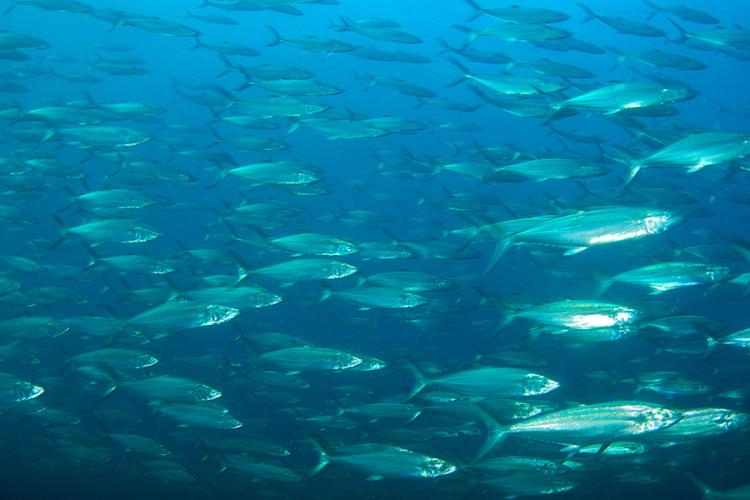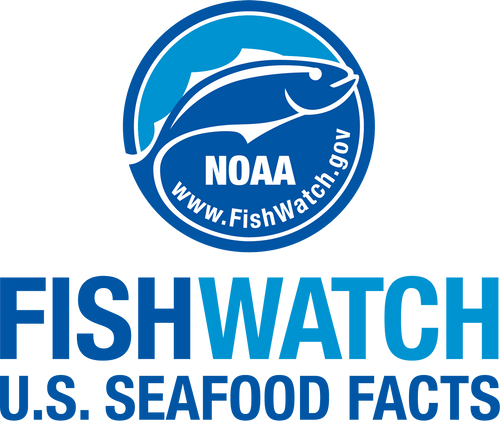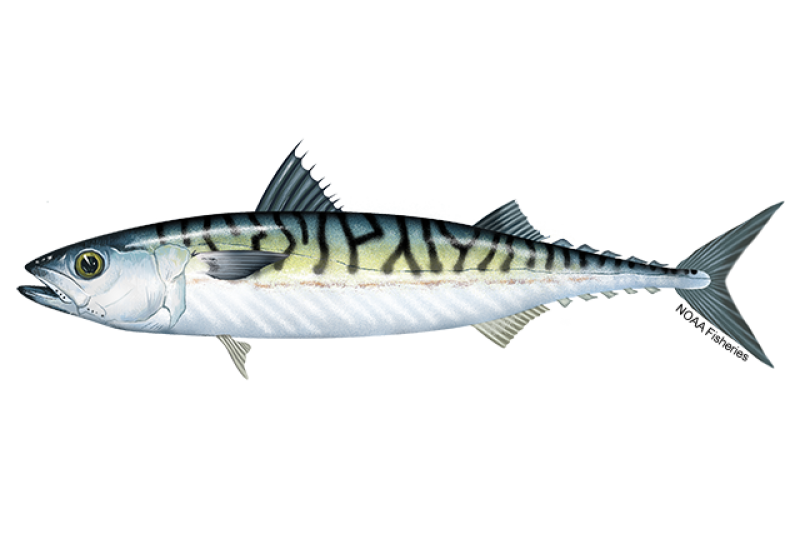 Spanish mackerel. Credit: Shutterstock
Spanish mackerel. Credit: Shutterstock
Spanish mackerel. Credit: Shutterstock
About the Species
 Spanish mackerel. Credit: Shutterstock
Spanish mackerel. Credit: Shutterstock
Spanish mackerel. Credit: Shutterstock
U.S. wild-caught Spanish mackerel is a smart seafood choice because it is sustainably managed and responsibly harvested under U.S. regulations.

Population
The stocks are not overfished.

Fishing Rate
Not subject to overfishing.

Habitat Impact
Fishing gears used to harvest Spanish mackerel have minimal impacts on habitat.

Bycatch
Bycatch is low because hook-and-line, cast nets, and gillnet gear are selective.
Population Status
- There are two stocks of Spanish mackerel: Gulf of Mexico and South Atlantic. According to the most recent stock assessments:
- The Gulf of Mexico stock is not overfished and is not subject to overfishing (2023 stock assessment). Summary stock assessment information can be found on Stock SMART.
- The South Atlantic stock is not overfished and is not subject to overfishing (2023 stock assessment). Summary stock assessment information can be found on Stock SMART.
- Prior to the 1980s, Spanish mackerel were heavily fished by commercial and recreational fishermen, but the fishery was unregulated. Stocks were below target levels, so managers implemented regulations to manage fishing rates. Today the Spanish mackerel populations are above target population levels.
- Fishing for Spanish mackerel has increased as fisheries for other species in the South Atlantic have become more restricted.
Appearance
- Spanish mackerel have a greenish back with silver sides and belly.
- They are covered with very tiny scales.
- They have yellow or olive green oval spots all over. These spots distinguish Spanish mackerel from cero mackerel, which have yellow-gold streaks along their midline.
- Spanish mackerel can be distinguished from king mackerel by their smaller size and the absence of the lateral line that drops abruptly below the second dorsal fin.
Biology
- Spanish mackerel grow fast, up to 13 pounds, and can live up to 12 years.
- They are able to reproduce by age 2.
- There are two distinct populations, one in the Gulf of Mexico and one in the Atlantic.
- They spawn from April to September off the North Carolina and Virginia coasts in the Atlantic Ocean and in shallow coastal waters in the eastern Gulf of Mexico.
- Spanish mackerel release their eggs in batches throughout the spawning season. Females can have 500,000 to 1.5 million eggs over the spawning season.
- Spanish mackerel swim in large, fast-moving schools.
- They migrate as the seasons and water temperatures change.
- Along the Atlantic coast, Spanish mackerel spend the winter off Florida and move northward to North Carolina in early April and to New York in June. As waters cool later in the year, they return south to Florida waters.
- In the eastern Gulf of Mexico, they migrate to the west of Cape San Blas, Florida. They remain in the northern Gulf of Mexico until September and migrate south along the coast in the fall.
- Spanish mackerel prey primarily on herring, menhaden, sardines, mullet, needlefish, and anchovy and, to a lesser degree, shrimp, crabs, and squid. They are often seen forcing schools of small fish into tight bundles and nearly pushing them out of the water when feeding.
- Dolphins and sharks prey on Spanish mackerel.
Where They Live
Range
- Spanish mackerel is found off the Atlantic coast of the United States and in the Gulf of Mexico.
Habitat
- Spanish mackerel mostly live in open water but are sometimes found over deep grass beds and reefs, as well as in shallow estuaries.
- They prefer water temperatures above 68° F.
Fishery Management
- NOAA Fisheries and the South Atlantic and Gulf of Mexico Fishery Management Councils manage the Spanish mackerel fishery.
- Managed under the Fishery Management Plan for the Coastal Migratory Pelagic Resources in the Gulf of Mexico and South Atlantic Region:
- Commercial fishermen must have a permit to harvest Spanish mackerel in federal waters.
- Annual catch limits are divided between the commercial and recreational fisheries for the Atlantic and Gulf of Mexico stocks. The commercial allocation is 55 percent in the Atlantic and 57 percent in the Gulf of Mexico.
- Seasonal and per-fishing-trip limits.
- Minimum size limit to allow fish time to mature and spawn.
- Spanish mackerel must be landed with heads and fins intact in both the commercial and recreational fisheries.
- Seasons for Atlantic and Gulf of Mexico stocks. Seasons can close early if quotas are reached.
- Prohibition on purse seine and drift gillnet fishing gear.
- Extends management area for Spanish mackerel through the Mid-Atlantic Fishery Management Council's jurisdiction (North Carolina to New York).
- The Atlantic States Marine Fisheries Commission works with the South Atlantic Fishery Management Council to coordinate management of Spanish mackerel fisheries in state waters to ensure they’re managed similarly to the fisheries in adjacent federal waters.
Harvest
- Commercial fishery:
- In 2022, commercial landings of Spanish mackerel totaled 2.8 million pounds and were valued at $4.6 million, according to the NOAA Fisheries commercial fishing landings database.
- Commercial landings of Spanish mackerel have generally been increasing in the Atlantic over the past decade.
- Gear types, habitat impacts, and bycatch:
- Commercial fishermen use cast nets, gillnets, and hook-and-line gear to harvest Spanish mackerel. Cast nets account for the majority of landings.
- Spanish mackerel are caught in coastal waters at or near the surface, so fishing gear has minimal impacts on habitat.
- Fishermen throw cast nets and set gillnets directly on schools of Spanish mackerel, so they rarely catch other species.
- Hook-and-line fisheries for mackerel are selective and have little bycatch.
- Recreational fishery:
- In 2022, recreational harvest of Spanish mackerel totaled 10.3 million pounds.
- Recreational catches of Spanish mackerel in the South Atlantic have remained stable while those in the Gulf of Mexico have decreased in recent years.
- Spanish mackerel is an important species for recreational fishermen, who often use them as bait for big game fishing.
- Recreational management measures include:
- Minimum size limits.
- Limits on the number of mackerel fishermen can catch.
- Spanish mackerel must be landed with their heads and fins intact.
- Charter vessel/headboat operators must have a vessel permit for coastal migratory fish and must comply with possession limits.
Scientific Classification
- Spanish mackerel is found off the Atlantic coast of the United States and in the Gulf of Mexico.
- Spanish mackerel mostly live in open water but are sometimes found over deep grass beds and reefs, as well as in shallow estuaries.
- They prefer water temperatures above 68° F.
Fishery Management
- NOAA Fisheries and the South Atlantic and Gulf of Mexico Fishery Management Councils manage the Spanish mackerel fishery.
- Managed under the Fishery Management Plan for the Coastal Migratory Pelagic Resources in the Gulf of Mexico and South Atlantic Region:
- Commercial fishermen must have a permit to harvest Spanish mackerel in federal waters.
- Annual catch limits are divided between the commercial and recreational fisheries for the Atlantic and Gulf of Mexico stocks. The commercial allocation is 55 percent in the Atlantic and 57 percent in the Gulf of Mexico.
- Seasonal and per-fishing-trip limits.
- Minimum size limit to allow fish time to mature and spawn.
- Spanish mackerel must be landed with heads and fins intact in both the commercial and recreational fisheries.
- Seasons for Atlantic and Gulf of Mexico stocks. Seasons can close early if quotas are reached.
- Prohibition on purse seine and drift gillnet fishing gear.
- Extends management area for Spanish mackerel through the Mid-Atlantic Fishery Management Council's jurisdiction (North Carolina to New York).
- The Atlantic States Marine Fisheries Commission works with the South Atlantic Fishery Management Council to coordinate management of Spanish mackerel fisheries in state waters to ensure they’re managed similarly to the fisheries in adjacent federal waters.
Harvest
- Commercial fishery:
- In 2022, commercial landings of Spanish mackerel totaled 2.8 million pounds and were valued at $4.6 million, according to the NOAA Fisheries commercial fishing landings database.
- Commercial landings of Spanish mackerel have generally been increasing in the Atlantic over the past decade.
- Gear types, habitat impacts, and bycatch:
- Commercial fishermen use cast nets, gillnets, and hook-and-line gear to harvest Spanish mackerel. Cast nets account for the majority of landings.
- Spanish mackerel are caught in coastal waters at or near the surface, so fishing gear has minimal impacts on habitat.
- Fishermen throw cast nets and set gillnets directly on schools of Spanish mackerel, so they rarely catch other species.
- Hook-and-line fisheries for mackerel are selective and have little bycatch.
- Recreational fishery:
- In 2022, recreational harvest of Spanish mackerel totaled 10.3 million pounds.
- Recreational catches of Spanish mackerel in the South Atlantic have remained stable while those in the Gulf of Mexico have decreased in recent years.
- Spanish mackerel is an important species for recreational fishermen, who often use them as bait for big game fishing.
- Recreational management measures include:
- Minimum size limits.
- Limits on the number of mackerel fishermen can catch.
- Spanish mackerel must be landed with their heads and fins intact.
- Charter vessel/headboat operators must have a vessel permit for coastal migratory fish and must comply with possession limits.
Scientific Classification
| Kingdom | Animalia | Phylum | Chordata | Class | Actinopterygii | Order | Scombriformes | Family | Scombridae | Genus | Scomberomorus | Species | maculatus |
|---|
Last updated by NOAA Fisheries on 09/06/2024
Featured News
 Fish and shellfish dishes. Credit: iStock
Fish and shellfish dishes. Credit: iStock
Seafood Facts

Is Spanish Mackerel Sustainable?
U.S. wild-caught Spanish mackerel is a smart seafood choice because it is sustainably managed and responsibly harvested under U.S. regulations.
Availability
Year-round.
Source
U.S. wild-caught mostly from Rhode Island to Alabama.
Taste
Spanish mackerel has a rich, pronounced flavor. For a milder flavor, cut out the outer bands of dark, strong-tasting meat along the midline.
Texture
Flaky and moist.
Color
Raw mackerel is grayish and oily. When cooked, mackerel is off-white to beige in color.
Health Benefits
Spanish mackerel is an excellent source of selenium, niacin, and vitamins B6 and B12. It is also rich in omega-3 fatty acids.
Nutrition Facts
Servings: 1; Serving Weight: 100 g (raw); Calories: 139; Protein: 19.29 g; Total Fat: 6.3 g; Total Saturated Fatty Acids: 1.828 g; Carbohydrate: 0 g; Total Sugars: 0 g; Total Dietary Fiber: 0 g; Cholesterol: 76 mg; Selenium: 36.5 mcg; Sodium: 59 mgMore Information
Last updated by NOAA Fisheries on 09/06/2024
Seafood News
 A signboard thanking patrons at Tuna Harbor Dockside Market in San Diego. Credit: Tuna Harbor Dockside Market.
A signboard thanking patrons at Tuna Harbor Dockside Market in San Diego. Credit: Tuna Harbor Dockside Market.
 Credit: NOAA Fisheries/Brianna Shaughnessy
Credit: NOAA Fisheries/Brianna Shaughnessy
 An oyster reef with lush greenery in the background. Credit: Adobe Stock
An oyster reef with lush greenery in the background. Credit: Adobe Stock
Research
Exempted Fishing Permit: Quantification of Bycatch Composition and Survival in the Commercial Menhaden Purse Seine Fishery
Gulf of Mexico Exempted Fishing Permit. For more information, contact: Dan Luers; (727) 824-5305,Daniel.Luers@noaa.gov or Jennifer Lee at Jennifer.Lee@noaa.gov
Outreach & Education
South Atlantic Saltwater Recreational Fisheries Snapshot
South Atlantic saltwater recreational fisheries fact sheets highlighting recent regional trends,…
Last updated by NOAA Fisheries on 09/06/2024






